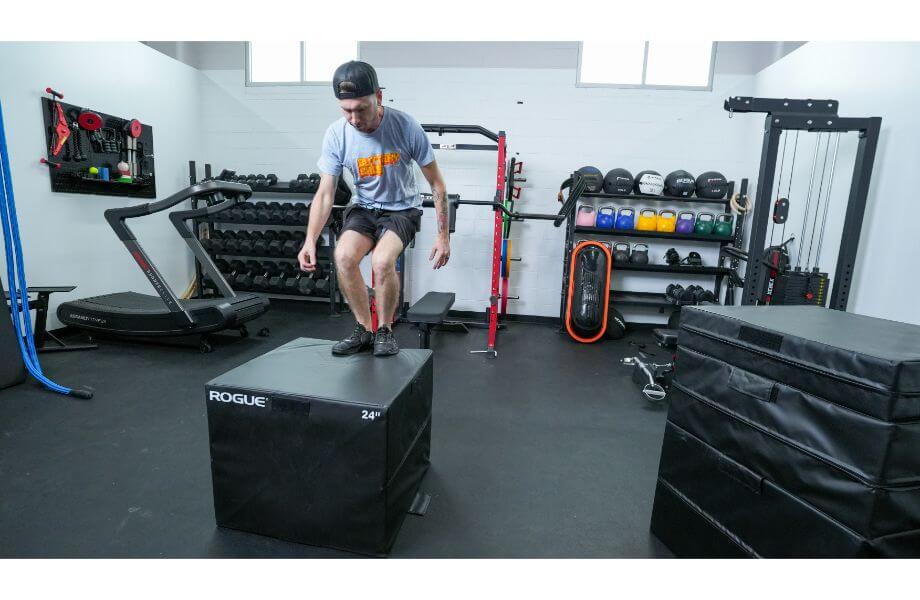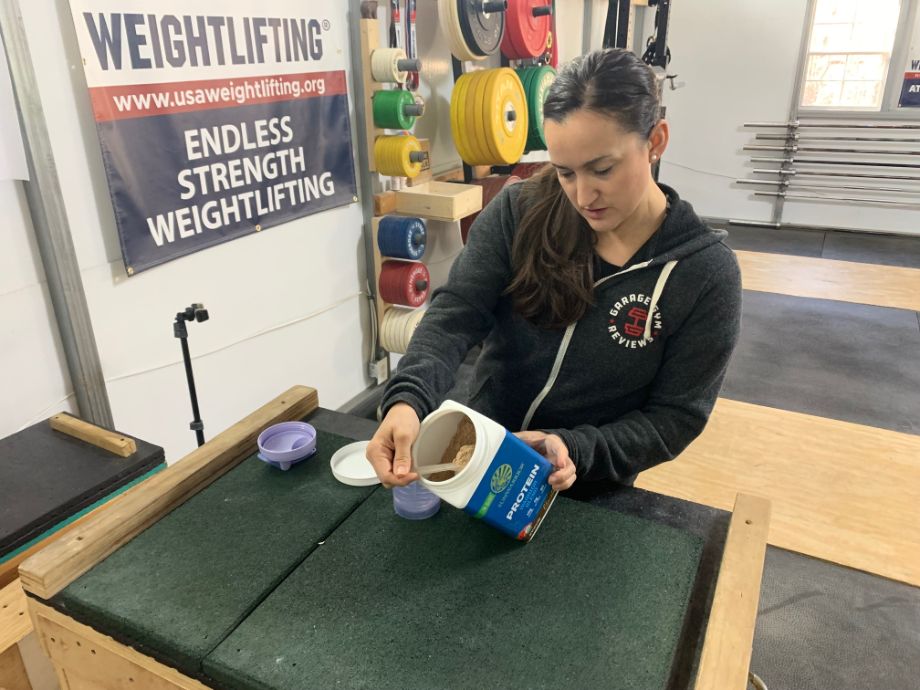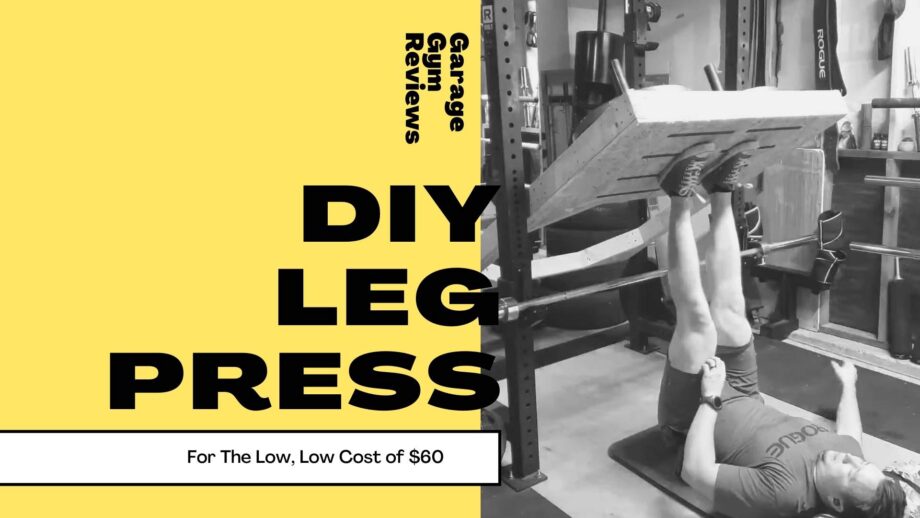If you have been around CrossFit gyms or browsed YouTube for a while, you have probably seen some crazy box jumps. Jumping as high as possible can look really cool until you try it and hurt yourself. Put those wild jump ambitions aside because Garage Gym Reviews will show you the correct way to do a box jump workout.
RELATED: CrossFit Exercises
Box jumps aren’t only about how high you can jump but how quickly you can apply force to gravity to jump. The fact lost among all those crazy is that box jumps are plyometric exercises that train power. And power (think moving weight fast) is a use it or lose it deal. The older you get, the harder power is to generate. Trust me; I’m a certified personal trainer.
Power (or the rate that energy is moved) can help you become faster and burn more calories1, but it will also set the stage for hypertrophy. And that’s just a couple of the reasons why doing box jumps with the proper form is essential. As a certified personal trainer (CPT) for the past 14 years, I’m here to offer tips and variations to get your box jump in top shape. I also consulted with Robbie Bagby, certified strength and conditioning specialist (CSCS) and owner of Foundation Fitness.
Let’s drive in and learn how to do this jumping exercise right!
How To Do a Box Jump Workout
- Have a plyometric box or a weight bench approx a foot in front of your feet.
- Sink into a quarter squat, bringing both arms behind you
- Throw your arms in front of you as you explode out of your squat, jumping up and forward
- Land with both feet securely on the box so that both feet land lightly.
- Step or lightly hop off the box and reset and repeat.
RELATED: Best Plyo Boxes
Note: Ensure a proper warm-up before attempting any box jump exercises. Here’s our guide to the best warm-up exercises.
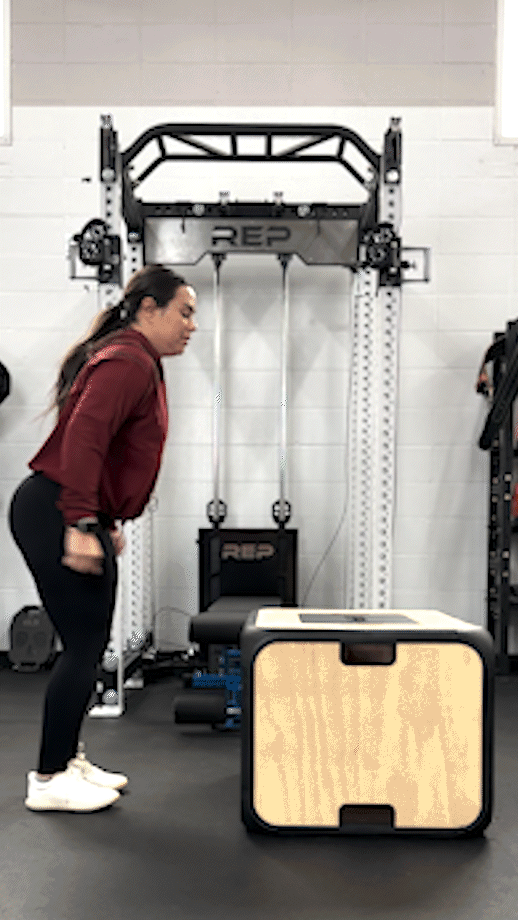
4 Benefits of Box Jumps
Besides looking cool and running faster, here are a few benefits of performing a box jump workout.
Improved Power
With box jumps, you’ll be priming your muscles to move very quickly, like a car going from zero to 60 MPH in a heartbeat. Plyometric exercises like box jumps performed regularly will improve your muscle’s ability to generate force faster1. And that, my lifting friends, means you’ll have gotten more powerful with a higher vertical jump. Stop and take a bow.
RELATED: Types of Strength Training
Increases Training Focus
There are exercises where you can mindlessly go along without a care in the world, but box jumps are not one of those exercises. The split second before you jump, you have all those thoughts like, “Am I going to miss this jump and hurt my shins?” You need to focus on the task at hand, which takes some guts to (in the words of Van Halen) go ahead and jump.
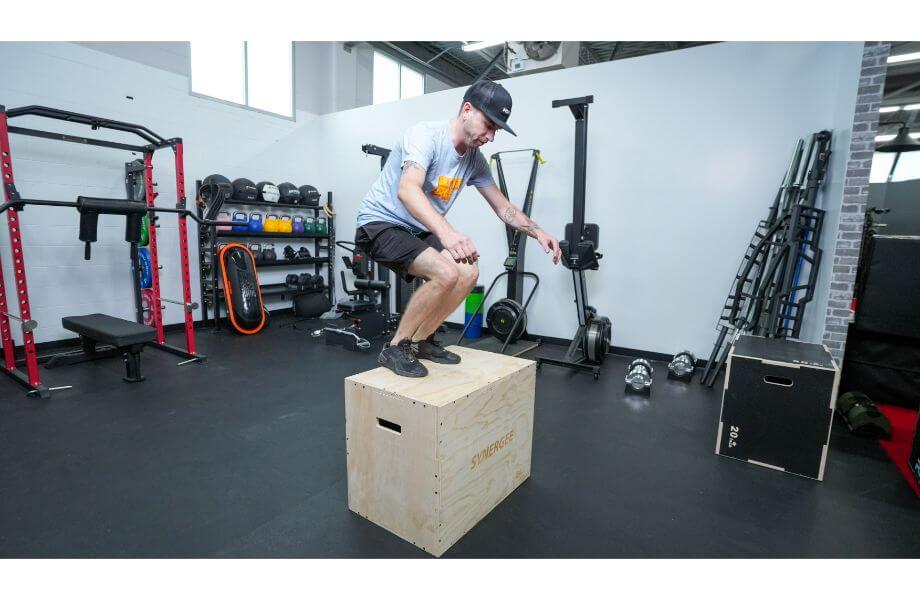
Sets the Table for Muscle
Your muscles have two types of muscle fibers2: slow twitch—endurance-type fibers that are hard to grow—and fast twitch muscle fibers. Fast twitch muscle fibers are larger and are where most of your muscle growth and explosive power comes from. Activating them with box jumps helps set the table to build muscle.
Improves Cardiovascular Fitness
Performing box jumps regularly will encourage you to breathe better while making your cardiovascular system better at processing oxygen3 in a shorter amount of time. This can also help improve your conditioning.
RELATED: Conditioning Workouts
Trainer Tips for Form
Box jumps seem simple and aren’t as technical as barbell deadlifts. But when you perform them, you realize how much force you need to generate to jump. Here are a few trainer tips for proper form.
Pay Attention to Your Set-Up
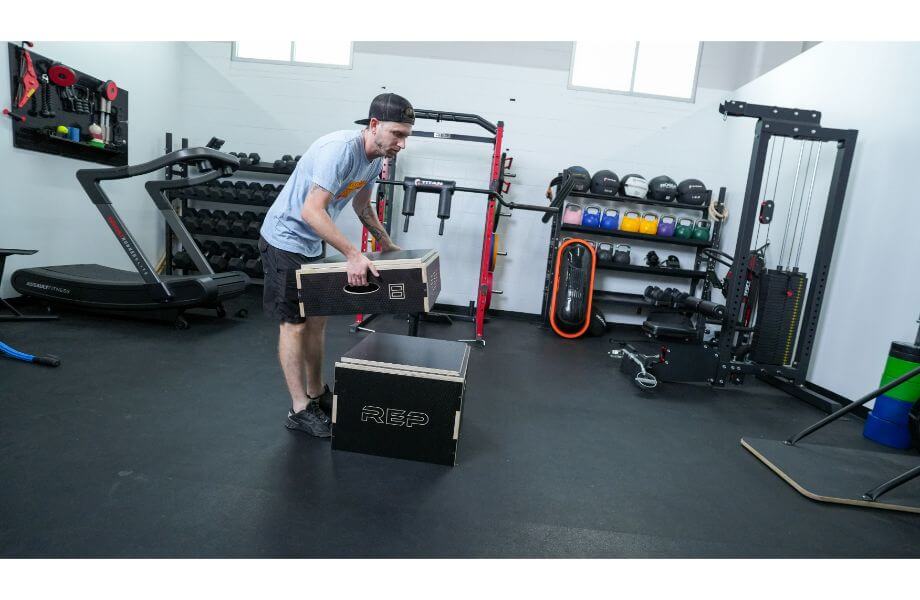
Leave enough room between you and the plyo box to make the jump without scraping your shins. Plus, pre-loading the bigger muscles of the glutes and quads with a quarter-to-half half bodyweight squat should give you the required juice to jump.
RELATED: Benefits of Squats
Start Small
It’s tempting to start with a higher box because of all those videos you have seen, but overestimating your abilities could lead to injury. It’s better to start with a low box of around 12 to 18 inches and gain confidence and technique before moving to a higher box.
Where You Start Is Where You Finish
Take note of where you start your jump, whether it’s a hinge or a quarter-to-half squat. Because when you land, you and your joints should end up in the same position as where you started. This suggests the box is the correct height and you have used your muscles correctly.
Be Quiet
When you land the jump, you need to land on the balls of your feet and roll down to your heels quietly. When you do this, you’ll have absorbed the force of the jump correctly, and your lower body joints will be happy with you.
Common Box Jump Workout Mistakes
Mistakes are a part of learning and are natural, but when you make mistakes with the box jump, you will learn a hard lesson. Better to avoid them by following these tips.
Selecting a Box That’s Too High
This is where ego takes over because exercisers think the higher the box, the higher the jump, the better. But, according to Robbie Bagby, CSCS and owner of Foundation Fitness, exercisers need to gain the intent of the exercise. “The height of the box is irrelevant. What I look for in my athletes when performing box jumps is maximum power, not box height. It’s about jumping as high as possible, no matter the height of the box,” explains Robbie.
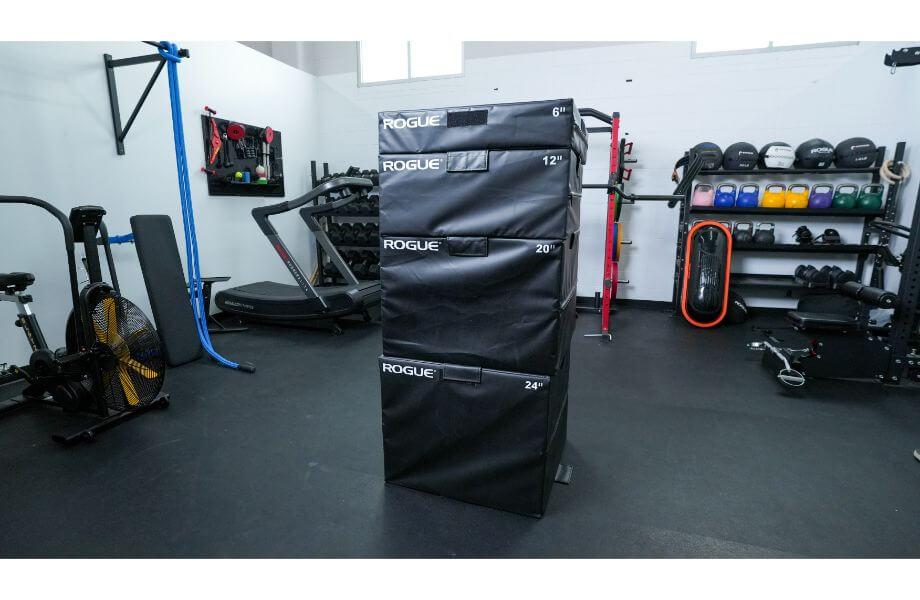
Landing Incorrectly
When your feet slam or slap onto the box, and you’re making a racket, this is a sign of incorrect landing mechanics. Landing like this is usually caused by the box being too high and straining to jump. Being quiet when you land and step down from the box ensures you absorb force correctly.
Box Jump Workout Variations
If you are still getting ready for box jumps or looking to take your strength training to the next level, here are three variations that might be up your alley.
Box Step-Ups
Why do it: The step-up exercise builds unilateral strength in your hip flexors, quads, and glutes, which is necessary for the box jump and its variations.
How to do it:
- Stand in front of a box with your feet hip-width apart.
- Place your right foot on the box and step up with your left foot until your feet are together.
- Step down gently with your left foot to the starting position and repeat on the opposite side.
- Keep alternating sides for the desired repetitions.
Note: Adding the best dumbbells or kettlebells will help increase the intensity of this exercise.
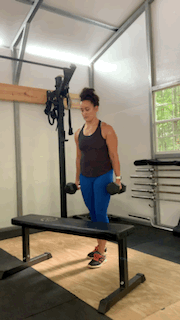
Seated Box Jump
Why do it: The seated box jump removes the eccentric contraction, so you can focus solely on improving the concentric power of your glutes, quads, and hamstrings.
How to do it:
- You will need a weight bench and a plyometric box for this exercise.
- Set up the weight bench approximately one to two feet from the plyo box.
- Sit down on the weight bench with your knees at a 90-degree angle.
- Bring both your arms behind you and stand up and jump onto the box while throwing your arms forward,
- Step down gently from the box and reset and repeat.
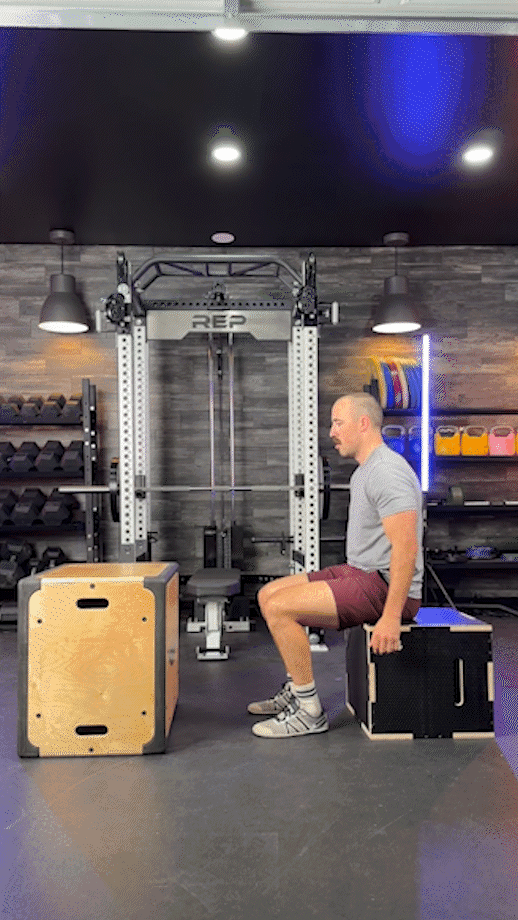
Burpee Box Jump
Why do it: Try the burpee box jump because you love pain and a challenge. Just kidding, well, kind of. Adding a burpee to a box jump helps improve your conditioning and full-body power.
How to do it:
- Stand with your feet shoulder-width apart, squat, put your hands on the ground, and kick your legs back into the push-up position.
- Perform a push-up, rise from your burpee, and bring your arms behind you when you are in a squat position.
- Throw your arms forward and jump onto a box.
- Step down gently to the starting position and reset and repeat for reps.
Note: Adding one of the best weighted vests can take this exercise to the next level.
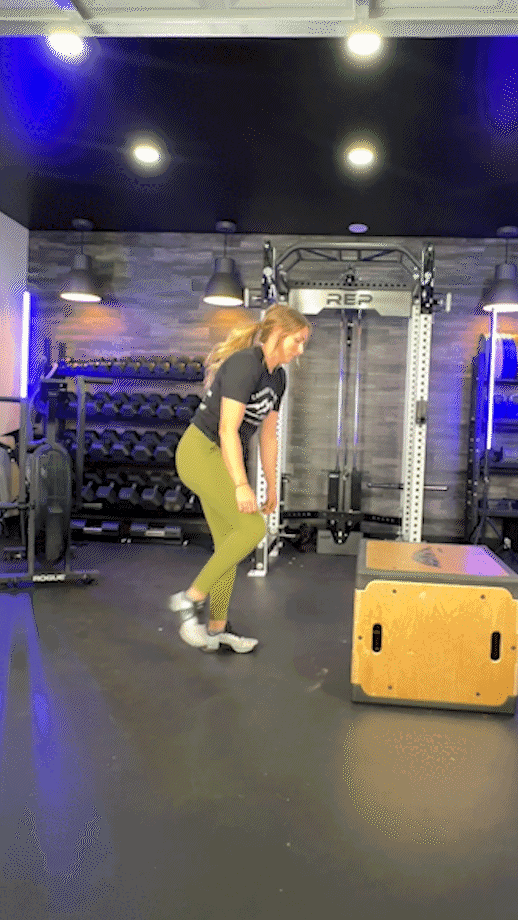
Box Jump Workout FAQs
Is box jump a good workout?
Box jumps are a great workout to improve your lower body’s size, strength, and power. Box jumps can also directly enhance the strength and power of your calves, glutes, and quads, helping you run faster and jump higher.
What does box jump train?
Box jumps train your quadriceps, calves, hamstrings, glutes, adductors, and core while developing lower body power and enhancing the strength of those muscles.
How long should you do box jumps?
How long you do box jumps depends on your goals. If your goal is to improve power, 2 to 4 sets of 3 to 6 repetitions is a good starting point, and 2 sets of 10 to 12 reps to enhance muscular power and endurance is a great starting point, per Sports (Basel)4.
How many times a week should you do box jumps?
One to two times per week should be enough for a beginner. When you are more advanced and looking to improve the power and strength of your lower body, two to three times per week is a good amount to aim for.
References
1. “Your Guide to Creating a Plyometrics Workout to Burn Fat” (2020, August 14) ISSA. Retrieved August 30, 2023 from https://www.issaonline.com/blog/post/your-guide-to-creating-a-plyometrics-workout-to-burn-fat
2. Wilson JM, Loenneke JP, Jo E, Wilson GJ, Zourdos MC, Kim JS. The effects of endurance, strength, and power training on muscle fiber type shifting. J Strength Cond Res. 2012 Jun;26(6):1724-9. doi: 10.1519/JSC.0b013e318234eb6f. PMID: 21912291.
3. Brown GA, Ray MW, Abbey BM, Shaw BS, Shaw I. Oxygen consumption, heart rate, and blood lactate responses to an acute bout of plyometric depth jumps in college-aged men and women. J Strength Cond Res. 2010 Sep;24(9):2475-82. doi: 10.1519/JSC.0b013e3181b22b63. PMID: 20168259.
4. Schoenfeld BJ, Grgic J, Van Every DW, Plotkin DL. Loading Recommendations for Muscle Strength, Hypertrophy, and Local Endurance: A Re-Examination of the Repetition Continuum. Sports (Basel). 2021 Feb 22;9(2):32. doi: 10.3390/sports9020032. PMID: 33671664; PMCID: PMC7927075.


